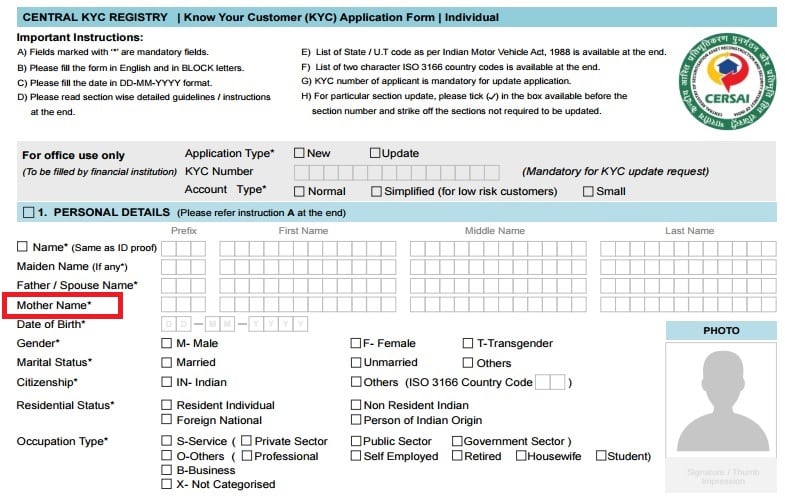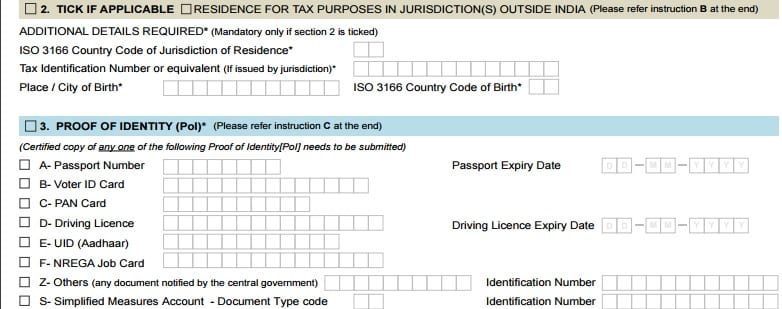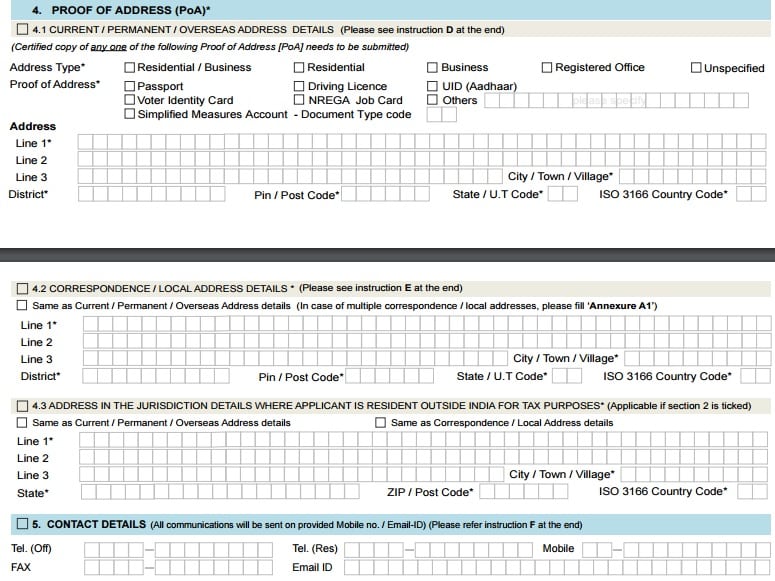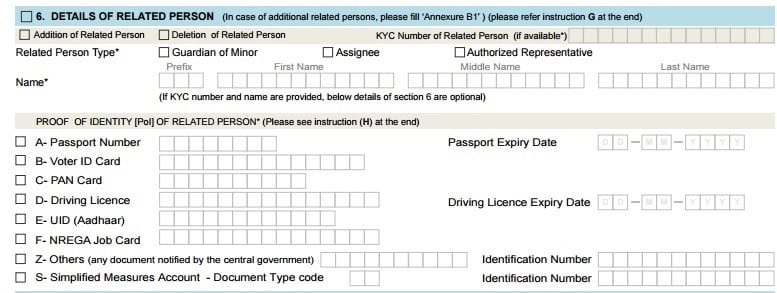From Feb 1, 2017, new investors in mutual funds will have to do CYKC (Central Know Your Customer) before investing. All Nationalised Banks have to associate CKYC ID. The CKYC will replace the existing KYC. What is the Central KYC or CKYC? How to fill cKYC Form? What is the difference between KYC, eKYC, and cKYC?
The program was announced by the Government of India in the 2012-13 Union Budget and went live in July 2016. With Central KYC (cKYC) program, once you finish the KYC process with a financial institution authorized to conduct KYC, it will be sufficient for you to invest in all the other financial products such as Banks, Mutual Funds, Insurance. Central KYC (cKYC) is being managed by The Central Registry of Securitization and Asset Reconstruction and Security Interest in India (CERSAI)
As of now, existing investors in mutual funds who are KYC compliant can continue investing in mutual funds. No updation is required from their end.
Table of Contents
What is Central KYC or cKYC?
When you do any transaction such as if you want to open a Bank account, or buy a Mutual Fund or buy insurance each of these institutions have to do KYC or Know your Customer. The Central KYC (cKYC) has been brought in to make the life easier for investors. So completing KYC process with any bank, Mutual Fund, or an insurance company will be enough and you won’t have to do this process again anywhere. Before the Central KYC (cKYC) there were separate KYC formats for different financial institutes like Mutual Funds, banks etc. The introduction of Central KYC (cKYC) aims to eliminate this dissimilarity across the investment platform.
Central KYC (cKYC) will store all the customer information at one central server that is accessible to all the financial institutions. After opening a KYC account, you will get a 14-digit identification number. So, you just have to show this number at the time of a new investment or purchasing a financial product with a financial institution. The number will have all your details saved centrally. It will save you and the company or bank from completing the tedious process of KYC all over again.
What is the difference between KYC, eKYC, and cKYC?
The objective of the KYC guidelines is to prevent identity theft, financial fraud, money laundering and terrorist financing. Money laundering is the process of concealing the source of money usually obtained through illegal sources such as drugs and arms trafficking, terrorism, extortion and theft. Our article Know Your Customer or KYC discusses why KYC is required.
KYC or Know your Customer: is the known and regular process in the Banks/Mutual Funds whereby the identity of an investor is verified based on written details submitted by him on a form, supplemented by an In-Person Verification (IPV) process. Once the verification is done successfully, the relevant investor data is entered into their database.
eKYC or electronic KYC: is KYC done with the help of an investor’s Aadhaar number. While completing the eKYC for Mutual Funds, the authentication of the investor’s identity can be done in following ways. Our article Aadhaar eKYC,eSign: Paperless for PAN, eNPS, Mutual Funds, Insurance discusses it in detail.Aadhaar eKYC,eSign: Paperless for PAN, eNPS, Mutual Funds,Insurance discusses it in detail.
- (a) Via One Time Password (Limits investments to Rs 50,000 per year per mutual funds and mandates investments via the online electronic mode)
- (b) Via Biometrics (No limits on the investment amount here unless those specifically imposed by the scheme / Fund House)
- This data is uploaded into the records of the KRA.
cKYC or Central KYC is an initiative of the Government of India where the aim is to have a structure in place which allows investors to do their KYC only once. CKYC compliance will allow an investor to transact/deal with all entities governed/regulated by Government of India / Regulator (RBI, SEBI, IRDA and PFRDA) without the need to complete multiple KYC formalities which are an inconvenience/hindrance as of now. It will allow for larger market participation by investors, easing their journey on the financial highway. The CKYC processing is handled by CERSAI.
Who is managing cKYC?
This new KYC platform is promoted by the Government and PSU Banks. Central KYC (cKYC) is being managed by The Central Registry of Securitization and Asset Reconstruction and Security Interest in India (CERSAI). You can visit CKYC website by clicking here.
Banks, insurance companies, Mutual Fund companies (AMCs) are now required to hand over their KYC records to CERSAI. CERSAI has now appointed DotEx International as its only managed service provider. Financial intuitions need to upload digital copies of client KYC data on this platform within three days after they onboard a client.
Institutions have to pay an advance fee to Central Registry of Securitization Asset Reconstruction and Security Interest of India (CERSAI). The requisite fee is deducted from this advance payment depending on the usage. Here is the fee structure for various transactions – upload: Rs. 0.80, download: Rs. 1.10, update: Rs. 1.15 per transaction.
How does cKYC help financial institutions?
Since the records are stored digitally, it helps intuitions de-duplicate data so that they don’t need to do KYC of customers multiple times. It helps institutions find out if the client is KYC compliant based on Aadhaar, PAN and other identity proofs. If the KYC details are updated on this platform by one entity, all other institutions get a real time update. Thus, the platform helps firms cut down costs substantially by avoiding multiplicity of registration and data upkeep.
What does one have to do for CKYC?
You now have to fill the new CKYC form. information that is currently sought on the current KYC form and the new CKYC form, is not same? CKYC requires additional information (for ex. mother’s name, FATCA information etc) .
- Central KYC (cKYC) asks about other details of the customer like maiden name, the name of mother, in the case of minors details of related persons, proof of permanent address where the local or corresponding address is not same.
- Along with the form, he has to submit a self-attested copy of his PAN card, and identity and address proofs, such as passport and Aadhaar card.
- Along with the CKYC form, photocopies of documents have to be physically verified and attested, and an in-person verification of the investor has to be done.
- NRI applicants can authorize a person to attest the documents. The may also conduct the in-person verification and confirm this in the KYC form.
- If you have more than one Correspondance or local address, then you can update them in Annexure A1.
- If you have more than one related person, then you can update their details in Annexure B1.
What does a first-time investor in mutual funds have to do for CKYC?
cKYC can be done through a mutual fund distributor, or the investor will have to visit the office of a mutual fund or a registrar. Note if you are existing Mutual Fund Investor, you don’t have to do anything.
How will I know that my cKYC application is successful?
You cannot check the CKYC status online. If one is allotted the KIN, it is confirmation that the investor is CKYC compliant. The KIN will be allotted by CERSAI within 4 – 5 working days.
Once the new form is processed a 14-digit KYC Identification Number (KIN) will be issued by CKYC, which has to be used to invest in all financial products including mutual funds. An SMS / email will be sent by CERSAI to the registered mobile number of the investor as soon as the KIN is generated at their end. Since CERSAI will not be sending any physical intimation, applicants should ideally provide their mobile number and/or email ID in the CKYC application form. A sample copy of the SMS that would be received by you from CERSAI is shown in the image below.
If the CKYC application is not processed/rejected for some reason, no intimation will be sent to the applicant from CERSAI. The entity processing your CKYC application will be aware of such rejections and can approach the financial institutions in case of any queries.
How many account types are there in Central KYC Form?
There are three account types in the Central KYC form – Normal, Simplified and Small. The account type can be guessed from the naming of KIN assigned.
For Normal Account, any of six officially valid documents (PAN, AADHAAR, Voter ID, Passport, Driving license, NREGA Job Card) can be submitted for the ID of the customer. If you do not fall in SMALL or SIMPLIFIED (Low-Risk Customers) category, then you are a NORMAL customer.
Simplified or Low-risk customers: LThe KYC identifier for Simplified Measures Account will have a prefix “L”. Low-risk customers are the individuals means customers who are not able to submit any of the 6 documents: Passport, driving license, PAN card, Voter ID, job card issued by NREGA or Aadhaar Card. They often face hurdles in submitting a proof of current or permanent address while opening a bank account. For such customers As per the RBI list, one can submit a copy of utility bills of any service provider, which is not more than two months old. These include telephone, piped gas, water, electricity or postpaid mobile phone bill. They can also submit property or municipal tax receipts; bank account or post office savings bank account statements; and pension or family pension payment orders issued to retired employees by Government departments or public sector undertakings, if these contain the address, to open an account. Details for Simplified Measures Account, there are additional Officially verified documents (OVDs) that are allowed as per RBI circular RBI/2015-16/42 dated July 1, 2015 – Point no. 2.3(i) & (ii) and point 3.2.2 I.A (iv) & (v)
Small Accounts: The KYC identifier for Small Account will have a prefix “S”. People who do not possess officially valid KYC documents can open a small account with the banks. These accounts can be opened by submitting a self-attested photograph along with the application by putting a signature or thumbprint on it in the presence of the bank official. These accounts will be initially valid for 12 months. Thereafter such accounts can be extended for another 12 months provided that the account holder provides a document showing that they have applied for the officially valid document within 12 months of the account opening.However, such account has some restrictions attached to it as listed below:
- There should not be more than Rs. 1,00,000 aggregate credits in a year.
- The aggregate withdrawals should not exceed Rs. 10,000 in a month.
- Balance in the account should not be more than Rs. 50,000 at any point in time.
Filling the cKYC Form
cKYC Form Section 1: Personal Details
Details such as Name(Same as ID Proof), Father/Spouse name, Maiden name(if any), Mother name, Gender, Date of Birth, Marital Status, Citizenship, Residential Status, Occupation Type has to be filled in this part.Note: If PAN is not available, Father’s name is mandatory.
cKYC Form Section 2: RESIDENCE FOR TAX PURPOSES IN JURISDICTION(S) OUTSIDE INDIA
This section has to be filled by the applicant in case of residence for tax purposes in jurisdictions outside India. Details such as ISO 3166 Country Code of Jurisdiction of Residence, Place/City of Birth, Tax Identification Number(TIN) or equivalent(If issued by jurisdiction), and ISO 3166 Country Code of Birth have to be filled in this section.
cKYC Form Section 3: PROOF OF IDENTITY (PoI)
If passport or driving licence has been submitted as the identity proof, then it is mandatory to furnish the expiry date of such documents in the form.
Notes:
• Identification Number has to be mentioned for submission of any other document as notified by the Central Government.
• For Simplified Measures Account, document type code has to be furnished in the form along with the Identification Number. Any of the following document can be submitted, and the appropriate code may be mentioned in the form based on the document submitted:
| Document Code | Document Type |
| 01 | Identity card with applicant’s photograph issued by Central/ State Government Departments, Statutory/ Regulatory Authorities, Public Sector Undertakings, Scheduled Commercial Banks, and Public Financial Institutions. |
| 02 | Letter issued by a gazette officer, with a duly attested photograph of the person. |
cKYC Form Section 4: PROOF OF ADDRESS (PoA)
Notes:
• Address Proof is required only if the document submitted for the Proof of Identity does not contain the address or the address mentioned in the document is no more valid.
• For overseas addresses, State/UT Code and PIN/Postcode is not mandatory.
• For multiple correspondence or local addresses, you have to fill and submit Annexure A1 along with the Central KYC Registry form.
• For the address verification of the applicant in case of Simplified Measures Account, any of the following document can be submitted, and the appropriate code may be mentioned in the form based on the document submitted:
| Document Code | Document Type |
| 01 | Utility bill which is not more than two months old of any service provider (electricity, telephone, post-paid mobile phone, piped gas, water bill). |
| 02 | Property or Municipal Tax receipt. |
| 03 | Bank account or Post Office savings bank account statement |
| 04 | Pension or family pension payment orders (PPOs) issued to retired employees by Government Departments or Public Sector Undertakings, if they contain the address. |
| 05 | ‘Letter of allotment of accommodation from employer issued by State or Central Government departments, statutory or regulatory bodies, public sector undertakings, scheduled commercial banks, financial institutions and listed companies. Similarly, leave and license agreements with such employers allotting official accommodation. |
| 06 | Documents issued by Government departments of foreign jurisdictions and letter issued by Foreign Embassy or Mission in India. |
Section 5: CONTACT DETAILS
Details to be furnished in this part include Office Telephone number, Residence Telephone number, Mobile number, FAX and Email Id.
Note: All the communication will be sent on the provided Mobile number/Email Id.
Section 6: DETAILS OF RELATED PERSON
In this part, Addition/Deletion of related person can be done. The related persons could be any one among the following: Guardian of Minor(used for Minor), Assignee(for Life Insurance Policy), Authorised Representative(used by NRI). If you don’t fall in any of the category skip the section.
The Assignee is the person to whom the title, rights and benefits under a life policy are assigned. One can usually come across an assignment where the policyholder is trying to use the life insurance policy as collateral against a loan he intends to raise. Assignment must be in writing and a notice to that effect must be given to the insurer. For example Mr X buys a house for which he needs a home loan of Rs. 25 lakh from a bank. Mr X takes a home loan against his policy of sum assured Rs. 25 lakh. To take a loan from the bank, he assigns the policy to that bank, and then the bank would be able to pay out the loan money to him. If Mr X failed to repay the loan, then the bank would surrender the policy and get their money back. The original policyholder will pay the premium before or on the payment due date and not the bank.
Proof of Identity proof has to be submitted for the related person. List of documents accepted for the identity proof of the related person is same as the documents mentioned in Section 3 above. For more related persons, you have to fill and submit Annexure B1 along with the CKYC form.
Section 7: REMARKS (If any)
Section 8: APPLICANT DECLARATION
This part contains the applicant’s declaration on the details furnished in the above sections. The applicant has to mention the date, place and put his/her signature/thumb impression in this section.
Section 9: ATTESTATION / FOR OFFICE USE ONLY
This section is for the official purpose of the financial institution to whom the KYC form will be submitted.
Note: The account type has to be filled by the financial institution as it is for official purpose only.
• Wherever state and country code is to be furnished, it has to be in agreement with the Indian Motor Vehicle Act, 1988 and ISO 3166 country code.
Related Articles
- How to Update or Correct Details in Aadhaar
- What is Aadhaar, How to enrol,Check Aadhaar status,Download e Aadhaar
- JAM Trinity: Jan Dhan Yojana, Aadhaar and Mobile number
- Digital India
- Know Your Customer or KYC
- For EPS Aadhaar made mandatory, Is Aadhaar mandatory?









Best blog, awesome content
Docboyz is the best place for digital platform for document collection. the world’s first integrated Growth Management Platform,
I had much confusion related to the KYC but after reading your article I got the solution of my confusion related to the KYC.
iSolve is a best CKYC solution providers. The best Central KYC software vendors in India provided by iSolve Technologies. The CKYC Software solutions used for banks, NBFC’s, financial institutions & e-wallet companies.
Please let me know why mutual funds are still insisting for KYC with any of the old 6 KRAs also in addition to cKYC. Why and what rule the old KRAs are still operating.
The Central Know Your Customer (C-KYC ) system unveiled by the government to unify KYC data across all financial regulators (RBI, SEBI, IRDA and PFRDA) seems a distant reality as it is being implemented at a slower-than-envisaged rate due to issues related to automation, process gaps and resolution of queries.
Mandated to be maintained by the Central Registry of Securitisation Asset Reconstruction and Security Interest of India (CERSAI), the lack of an application programming interface (called API) with the C-KYC system is making life difficult for SEBI-registered KYC registration agencies to upload data manually.
Although CKYC is a one-stop solution for KYC requirements of all
FIs, it is marred by some fallacies:
• The CERSAI’s CKYC is not integrated with other KYC repositories,
which in turn requires customers to provide KYC documents again.
• KYC documents have to be submitted in paper format as there is no
digital or paperless onboarding process
http://bemoneyaware.com/ckyc-central-kyc-banks-mutualfunds-insurance/
IN THE LINK ABOVE, THE FOLLOWING LINE APPEARS:
Once the verification is done successfully, the relevant investor data is entered into the KRA Registration Agency (KRA) system and subsequently uploaded to their database.
PERHAPS THAT IS A TYPO AND YOU MEAN KYC REGISTRATION AGENCY AND NOT KRA REGISTRATION AGENCY. FOR THE SANITY OF NEWBIES LIKE ME, PLEASE CORRECT IT. THANK YOU PSINGH
Thanks for pointing out.
We meant into the KRA database and we have modified accordingly
Very helpful and informative.